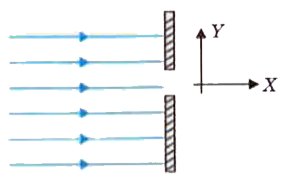Consider figure for photoemission. How would you reconcile with momentum-conservation? Note light (photons) have momentum in a different direction than the emitted electrons.

During photoelectric emission, the momentum of incident photon is transfered to the metal. At microscopic level, atoms of a metal absorb the photon and its momentum is transfered mainly to the nucleus and electrons. The electron excited is emitted. Therefore, the conservation of momentum is to be considerd as the momentum of incident photon transfered to the nucleus and electrons.
Topper's Solved these Questions
- DUAL NATURE OF RADIATION AND MATTERBook:PRADEEPChapter:DUAL NATURE OF RADIATION AND MATTERExercise:Long answer
Explore 1 Video
- DUAL NATURE OF RADIATION AND MATTERBook:PRADEEPChapter:DUAL NATURE OF RADIATION AND MATTERExercise:Higher order thinking skills
Explore 1 Video
- DUAL NATURE OF RADIATION AND MATTERBook:PRADEEPChapter:DUAL NATURE OF RADIATION AND MATTERExercise:NCERT Exerciese question
Explore 1 Video
- CURRENT ELECTRICITYBook:PRADEEPChapter:CURRENT ELECTRICITYExercise:Problems for Practice (B)
Explore 2 Videos
- ELECTROMAGNETIC INDUCTION & ALTERNATING CURRENTBook:PRADEEPChapter:ELECTROMAGNETIC INDUCTION & ALTERNATING CURRENTExercise:Multiple Choice Questions
Explore 1 Video
Similar Questions
Consider figure for photoemission. How would you reconcile with momentum-conservation? Note light (photons) have momentum in a different direction than the emitted electrons.

View SolutionConsider figure for photoemission. How would you reconcile with momentum-conservation? Note light (photons) have momentum in a different direction than the emitted electrons.

View Solution
Knowledge Check
A parallel beam of electrons travelling in x-direction falls on a slit of width d (see figure). If after passing the slit, an electron acquires momentum py in the y-direction then for a majority of electrons passing through the slit (h is Planck's constant):
 A∣∣Py∣∣d>hB∣∣Py∣∣d<hC∣∣Py∣∣d=hD∣∣Py∣∣d>>h
A∣∣Py∣∣d>hB∣∣Py∣∣d<hC∣∣Py∣∣d=hD∣∣Py∣∣d>>hA parallel beam of electrons travelling in X-direction falls on a slit of width d (see figure). If after passing the slit, an electron acquires momentum py in the Y-direction, then for a majority of electrons passing through the slit (h is Planck's constant):
 A∣∣py∣∣d=hB∣∣py∣∣d>hC∣∣py∣∣d<hD∣∣py∣∣d>>h
A∣∣py∣∣d=hB∣∣py∣∣d>hC∣∣py∣∣d<hD∣∣py∣∣d>>hThe momentum of a photon having energy equal to the rest energy of an electron is
AzeroB2.73×10−22kgms−1C1.99×10−24kgms−1Dinfinite
A parallel beam of electrons , travelling in x - direction , falls on a slit of width d (see the figure) . If after passing the slit, an electron acquires momentum Py in the y direction, then for a majority of electrons passing through the slit , (h is Planck's constant)

View SolutionA Bohr hydrogen atom at rest in free space undergoes a transition from the energy level n=2 to n=1, emitting a photon in the positive x direction. Since this photon has momentum, the atom must recoil in the negative x direction. Find the recoil velocity of the atom.
View SolutionPhoton having wavelength 12.4nm was allowed to strike a metal plate having work function 25eV.Calculate the-
(a) Maximum kinetic energy of photoelectrons emitted in eV.
(b) Wavelength of electron with maximum kinetic energy in A∘.
(c ) Calculate the uncertainity in wavelength of emitted electron, if the uncertainity in the momentum is 6.62×1020kgm/sec
View SolutionStatement -1: In process of photoelectric emission , all emitted electrons donot have sam Kinetic energy
Statement-2: If radiation falling on photosensitive surface of a metal consits of different wavelength, then energy acquired by electrons absorbing photons of different wavelength shall be different.
View SolutionIn an experiment on photoelectric effect, a photon is incident on an electron from one direction and the photoelectron is emitted almost in the opposite direction. Does this violate conservation of momentum ?
View Solution
